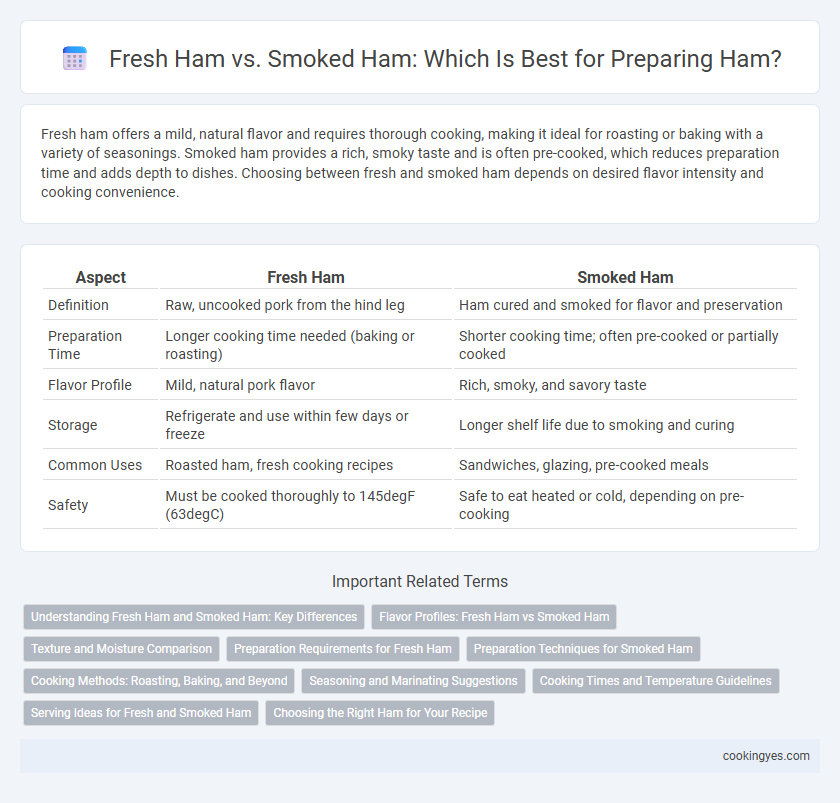Fresh ham offers a mild, natural flavor and requires thorough cooking, making it ideal for roasting or baking with a variety of seasonings. Smoked ham provides a rich, smoky taste and is often pre-cooked, which reduces preparation time and adds depth to dishes. Choosing between fresh and smoked ham depends on desired flavor intensity and cooking convenience.
Table of Comparison
| Aspect | Fresh Ham | Smoked Ham |
|---|---|---|
| Definition | Raw, uncooked pork from the hind leg | Ham cured and smoked for flavor and preservation |
| Preparation Time | Longer cooking time needed (baking or roasting) | Shorter cooking time; often pre-cooked or partially cooked |
| Flavor Profile | Mild, natural pork flavor | Rich, smoky, and savory taste |
| Storage | Refrigerate and use within few days or freeze | Longer shelf life due to smoking and curing |
| Common Uses | Roasted ham, fresh cooking recipes | Sandwiches, glazing, pre-cooked meals |
| Safety | Must be cooked thoroughly to 145degF (63degC) | Safe to eat heated or cold, depending on pre-cooking |
Understanding Fresh Ham and Smoked Ham: Key Differences
Fresh ham is raw, uncured pork that requires thorough cooking to an internal temperature of 145degF for safe consumption, offering a mild and natural pork flavor. Smoked ham undergoes curing and smoking processes, resulting in a salty, smoky taste and longer shelf life, with some varieties precooked and ready to eat. Understanding these differences helps in selecting the appropriate ham type for recipes and cooking methods.
Flavor Profiles: Fresh Ham vs Smoked Ham
Fresh ham offers a mild, natural pork flavor with a tender texture, making it ideal for versatile seasoning and slow-cooking methods like roasting or braising. Smoked ham delivers a robust, smoky taste infused through the curing and smoking process, which imparts a distinctive depth and saltiness suited for grilling, baking, or serving cold. Understanding these flavor profiles helps tailor recipes to highlight the subtle freshness or rich, smoky complexity unique to each ham type.
Texture and Moisture Comparison
Fresh ham boasts a tender texture and higher moisture content due to its raw, uncured state, making it ideal for slow roasting or braising to retain juiciness. Smoked ham undergoes curing and smoking processes that produce a firmer texture and reduced moisture levels, resulting in a more concentrated flavor and slightly drier bite. Choosing between fresh and smoked ham depends on the desired meal outcome, with fresh ham offering a succulent, tender finish and smoked ham providing a robust, savory profile.
Preparation Requirements for Fresh Ham
Fresh ham requires thorough curing or cooking before consumption to ensure safety, as it is raw pork from the hind leg. It must be cooked to an internal temperature of 145degF (63degC) followed by a resting period of three minutes to eliminate harmful bacteria. Preparation often involves brining, seasoning, and slow roasting or braising to develop flavor and tenderize the meat.
Preparation Techniques for Smoked Ham
Preparation techniques for smoked ham involve brining or dry curing to enhance flavor and moisture retention before smoking. The smoking process typically uses hardwoods like hickory or apple to infuse the ham with a rich, savory taste and promote a tender texture. Controlling temperature and smoke duration is essential to achieve a uniform cure and prevent over-drying.
Cooking Methods: Roasting, Baking, and Beyond
Fresh ham requires longer cooking times and higher temperatures for roasting or baking to ensure it is fully cooked, often benefiting from slow roasting to maintain moisture and tenderness. Smoked ham, already cured and partially cooked, generally needs only reheating at lower temperatures to avoid drying out while enhancing its smoky flavor. Both types can be prepared using various methods, but fresh ham excels with seasoning and marinade applications before roasting, while smoked ham suits glazing and baking for added sweetness and caramelization.
Seasoning and Marinating Suggestions
Fresh ham benefits from a robust seasoning blend of garlic, rosemary, thyme, and black pepper, allowing the flavors to deeply penetrate during a 12-24 hour marinade in a mixture of olive oil and apple cider vinegar. Smoked ham, already infused with smoky flavors, requires a lighter touch--suggest seasoning with honey, Dijon mustard, and cloves before a brief marination to enhance sweetness without overpowering the smoke. Both preparation methods emphasize balancing saltiness and aromatic spices to elevate the natural taste of the ham.
Cooking Times and Temperature Guidelines
Fresh ham requires cooking at an internal temperature of 145degF (63degC) followed by a rest period of three minutes to ensure safety and tenderness. Smoked ham is typically pre-cooked and needs reheating to 140degF (60degC) for ready-to-eat cuts or 165degF (74degC) for uncured varieties to maintain flavor and texture. Cooking times vary based on weight, with fresh ham taking about 20 minutes per pound and smoked ham requiring approximately 10-15 minutes per pound for proper heating.
Serving Ideas for Fresh and Smoked Ham
Fresh ham offers a mild flavor and tender texture, ideal for roasting with herbs like rosemary, garlic, and thyme to enhance its natural taste. Smoked ham provides a rich, smoky profile perfect for slicing and serving cold on sandwiches or paired with sweet glazes such as honey mustard or pineapple for a savory-sweet balance. Both varieties complement side dishes like mashed potatoes, roasted vegetables, or a fresh green salad, making them versatile choices for diverse meal occasions.
Choosing the Right Ham for Your Recipe
Fresh ham, derived from the hind leg of a pig, offers a mild, natural flavor ideal for slow roasting and recipes that require a tender, juicy texture. Smoked ham undergoes curing and smoking processes that infuse a rich, savory taste, making it perfect for dishes needing a pronounced smoky aroma and a firmer texture. Selecting the right ham depends on your recipe's flavor profile and cooking method, with fresh ham suited for customizable seasoning and smoked ham enhancing dishes with its bold, smoky character.
Fresh Ham vs Smoked Ham for preparation Infographic

 cookingyes.com
cookingyes.com